Abstract
Fetal behavioural patterns were examined to test whether they could be used to localise sites of brain damage antenatally. Decreased fetal movement, persistent nonreactive fetal heart rate (FHR) pattern, and/or central nervous system malformation were used as indicators of possible neurological impairment. Ten fetuses tested in this way underwent further ultrasound examination observing movement of the extremities, chest wall (breathing), and eye and mouth, and active/quiet FHR patterns. Eight of these 10 fetuses were found on postnatal examination to have a brain impairment. The fetuses having potential in utero brain impairment were divided into four groups: those with (1) lesion sites at, or caudal to, the pons-medulla that were specifically identified by fetal behaviour, (2) diffuse lesions in the brain which, although resulting in abnormal behaviour, could not be localised by this behaviour, (3) lesions localised in the cerebral hemisphere(s) but with no abnormal behaviour and (4) temporally abnormal behaviour in utero, finally changing over to a normal pattern with no neonatal neurological abnormality. A screening system for the antenatal assessment of brain impairment is thus proposed.
Full text
PDF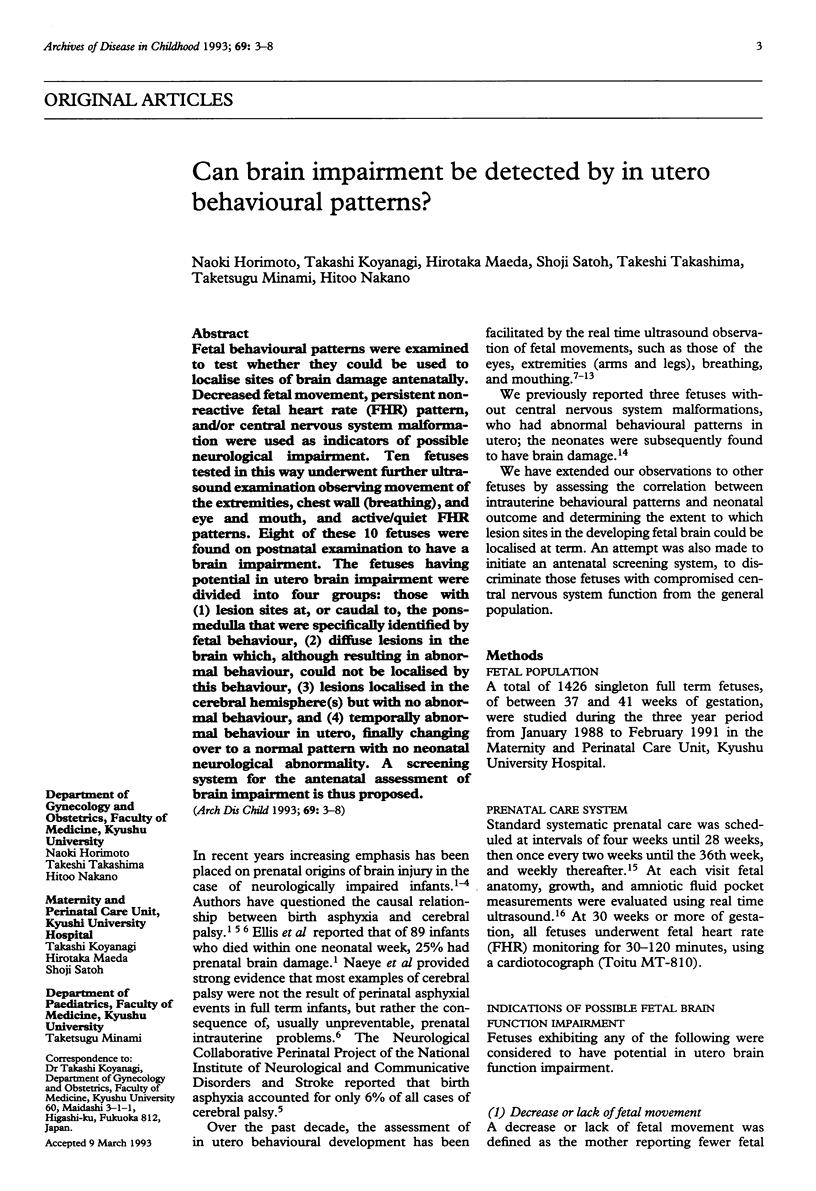
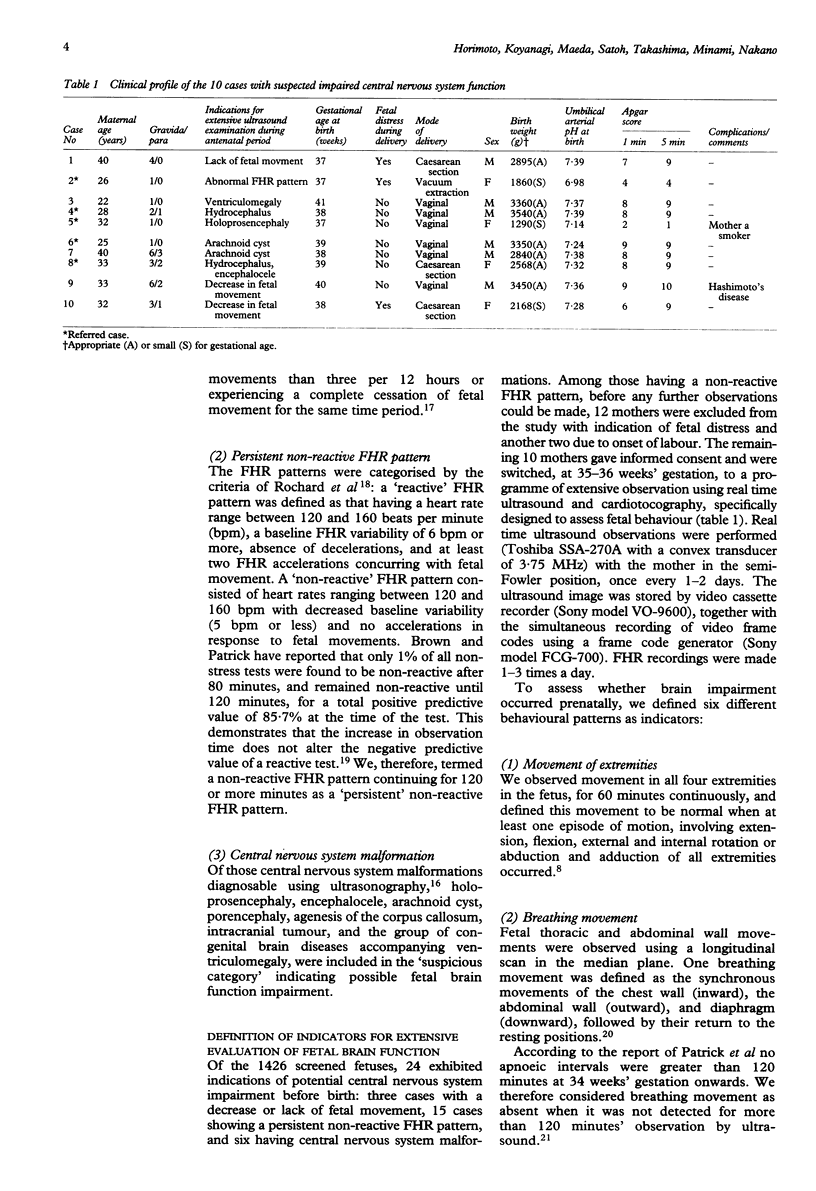
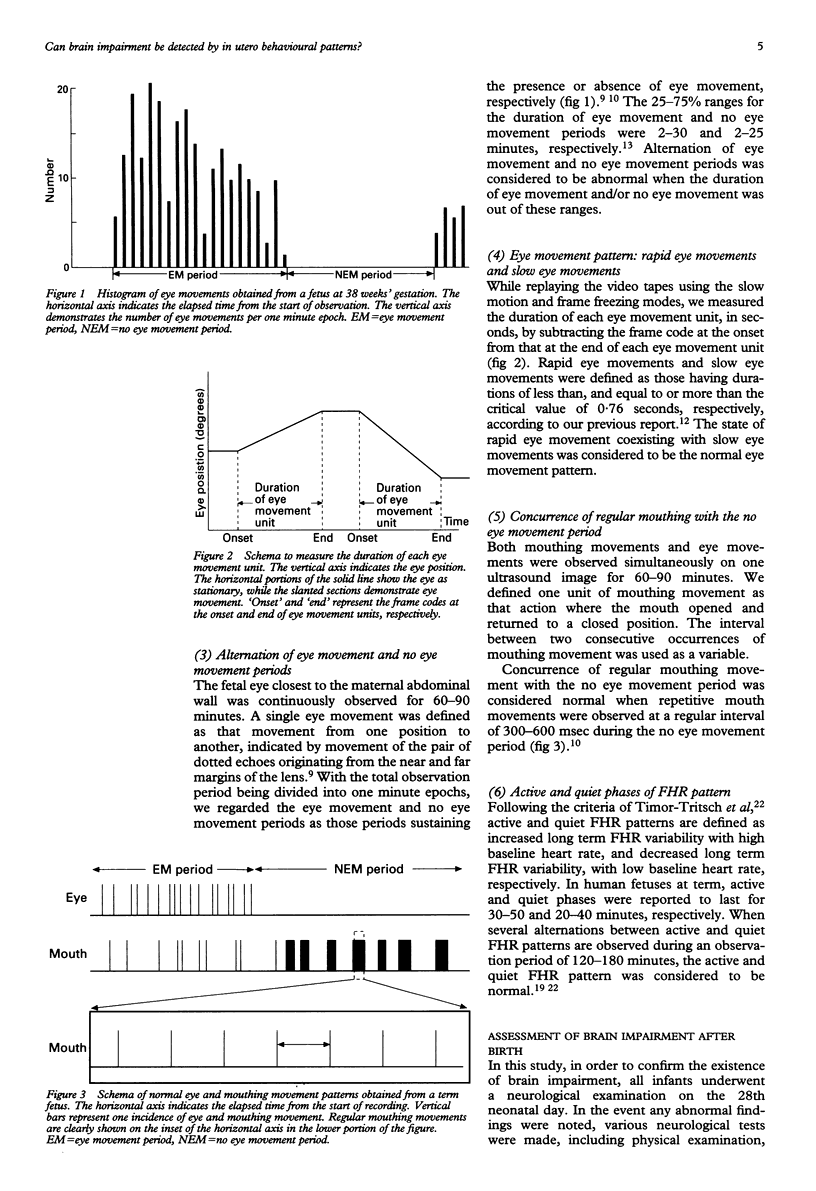

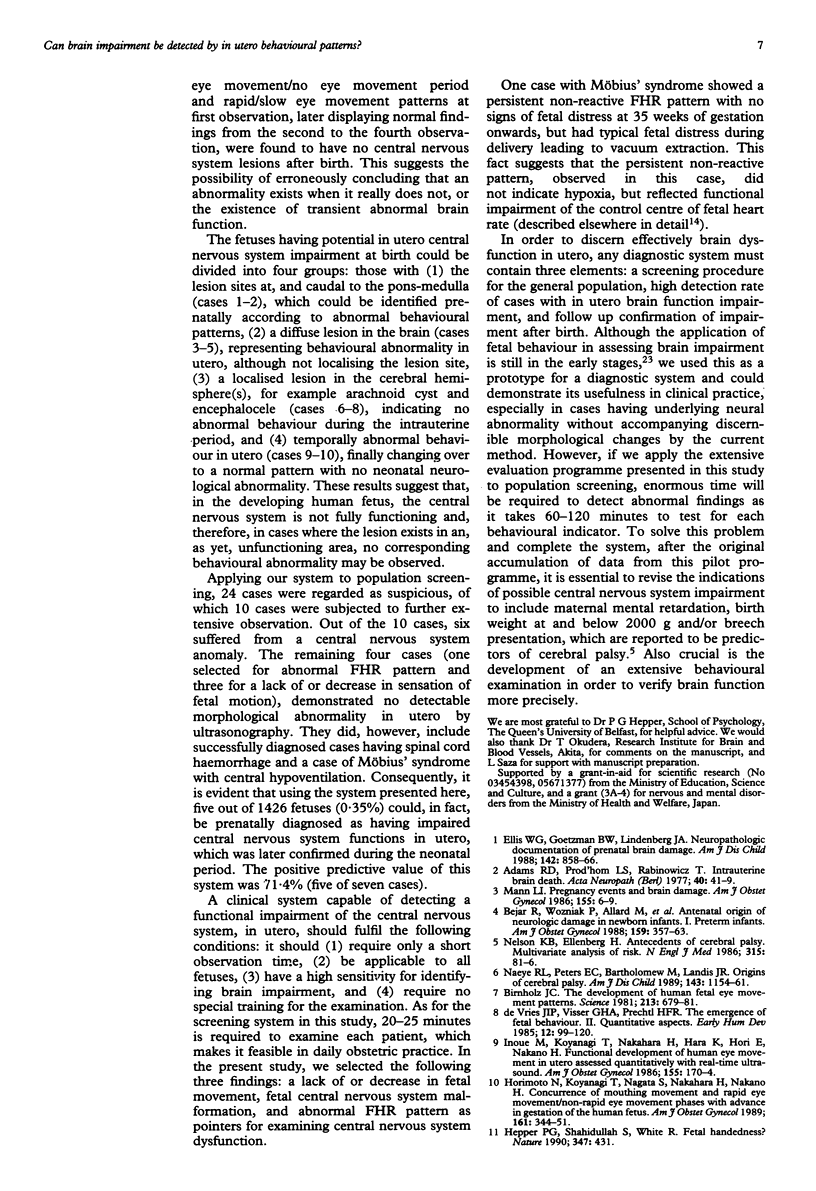
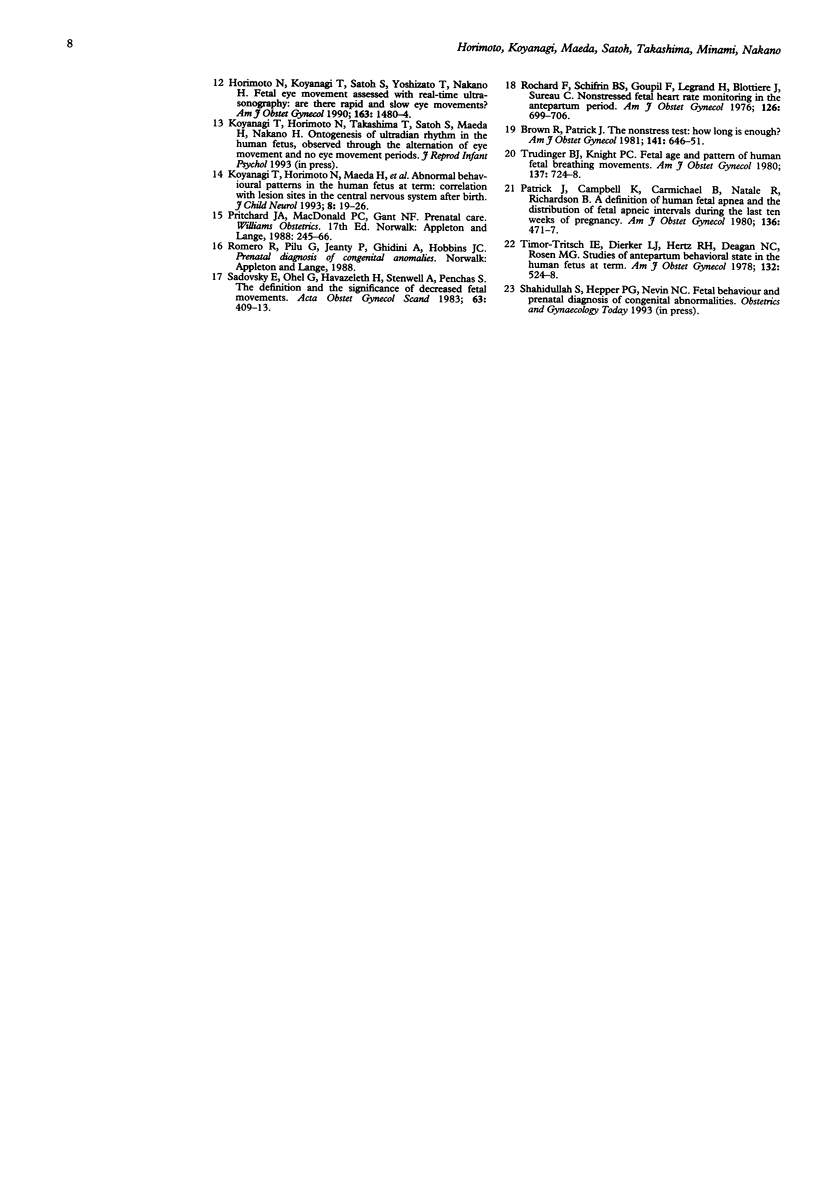
Selected References
These references are in PubMed. This may not be the complete list of references from this article.
- Bejar R., Wozniak P., Allard M., Benirschke K., Vaucher Y., Coen R., Berry C., Schragg P., Villegas I., Resnik R. Antenatal origin of neurologic damage in newborn infants. I. Preterm infants. Am J Obstet Gynecol. 1988 Aug;159(2):357–363. doi: 10.1016/s0002-9378(88)80084-x. [DOI] [PubMed] [Google Scholar]
- Birnholz J. C. The development of human fetal eye movement patterns. Science. 1981 Aug 7;213(4508):679–681. doi: 10.1126/science.7256272. [DOI] [PubMed] [Google Scholar]
- Brown R., Patrick J. The nonstress test: how long is enough? Am J Obstet Gynecol. 1981 Nov 15;141(6):646–651. doi: 10.1016/s0002-9378(15)33305-6. [DOI] [PubMed] [Google Scholar]
- Ellis W. G., Goetzman B. W., Lindenberg J. A. Neuropathologic documentation of prenatal brain damage. Am J Dis Child. 1988 Aug;142(8):858–866. doi: 10.1001/archpedi.1988.02150080064025. [DOI] [PubMed] [Google Scholar]
- Hepper P. G., Shahidullah S., White R. Origins of fetal handedness. Nature. 1990 Oct 4;347(6292):431–431. doi: 10.1038/347431b0. [DOI] [PubMed] [Google Scholar]
- Horimoto N., Koyanagi T., Nagata S., Nakahara H., Nakano H. Concurrence of mouthing movement and rapid eye movement/non-rapid eye movement phases with advance in gestation of the human fetus. Am J Obstet Gynecol. 1989 Aug;161(2):344–351. doi: 10.1016/0002-9378(89)90517-6. [DOI] [PubMed] [Google Scholar]
- Horimoto N., Koyanagi T., Satoh S., Yoshizato T., Nakano H. Fetal eye movement assessed with real-time ultrasonography: are there rapid and slow eye movements? Am J Obstet Gynecol. 1990 Nov;163(5 Pt 1):1480–1484. doi: 10.1016/0002-9378(90)90609-b. [DOI] [PubMed] [Google Scholar]
- Inoue M., Koyanagi T., Nakahara H., Hara K., Hori E., Nakano H. Functional development of human eye movement in utero assessed quantitatively with real-time ultrasound. Am J Obstet Gynecol. 1986 Jul;155(1):170–174. doi: 10.1016/0002-9378(86)90105-5. [DOI] [PubMed] [Google Scholar]
- Koyanagi T., Horimoto N., Maeda H., Kukita J., Minami T., Ueda K., Nakano H. Abnormal behavioral patterns in the human fetus at term: correlation with lesion sites in the central nervous system after birth. J Child Neurol. 1993 Jan;8(1):19–26. doi: 10.1177/088307389300800103. [DOI] [PubMed] [Google Scholar]
- Mann L. I. Pregnancy events and brain damage. Am J Obstet Gynecol. 1986 Jul;155(1):6–9. doi: 10.1016/0002-9378(86)90066-9. [DOI] [PubMed] [Google Scholar]
- Naeye R. L., Peters E. C., Bartholomew M., Landis J. R. Origins of cerebral palsy. Am J Dis Child. 1989 Oct;143(10):1154–1161. doi: 10.1001/archpedi.1989.02150220044018. [DOI] [PubMed] [Google Scholar]
- Nelson K. B., Ellenberg J. H. Antecedents of cerebral palsy. Multivariate analysis of risk. N Engl J Med. 1986 Jul 10;315(2):81–86. doi: 10.1056/NEJM198607103150202. [DOI] [PubMed] [Google Scholar]
- Patrick J., Campbell K., Carmichael L., Natale R., Richardson B. A definition of human fetal apnea and the distribution of fetal apneic intervals during the last ten weeks of pregnancy. Am J Obstet Gynecol. 1980 Feb 15;136(4):471–477. doi: 10.1016/0002-9378(80)90673-0. [DOI] [PubMed] [Google Scholar]
- Rochard F., Schifrin B. S., Goupil F., Legrand H., Blottiere J., Sureau C. Nonstressed fetal heart rate monitoring in the antepartum period. Am J Obstet Gynecol. 1976 Nov 15;126(6):699–706. doi: 10.1016/0002-9378(76)90523-8. [DOI] [PubMed] [Google Scholar]
- Sadovsky E., Ohel G., Havazeleth H., Steinwell A., Penchas S. The definition and the significance of decreased fetal movements. Acta Obstet Gynecol Scand. 1983;62(5):409–413. doi: 10.3109/00016348309154211. [DOI] [PubMed] [Google Scholar]
- Timor-Tritsch I. E., Dierker L. J., Hertz R. H., Deagan N. C., Rosen M. G. Studies of antepartum behavioral state in the human fetus at term. Am J Obstet Gynecol. 1978 Nov 1;132(5):524–528. doi: 10.1016/0002-9378(78)90747-0. [DOI] [PubMed] [Google Scholar]
- Trudinger B. J., Knight P. C. Fetal age and patterns of human fetal breathing movements. Am J Obstet Gynecol. 1980 Jul 15;137(6):724–728. doi: 10.1016/s0002-9378(15)33249-x. [DOI] [PubMed] [Google Scholar]
- de Vries J. I., Visser G. H., Prechtl H. F. The emergence of fetal behaviour. II. Quantitative aspects. Early Hum Dev. 1985 Nov;12(2):99–120. doi: 10.1016/0378-3782(85)90174-4. [DOI] [PubMed] [Google Scholar]


